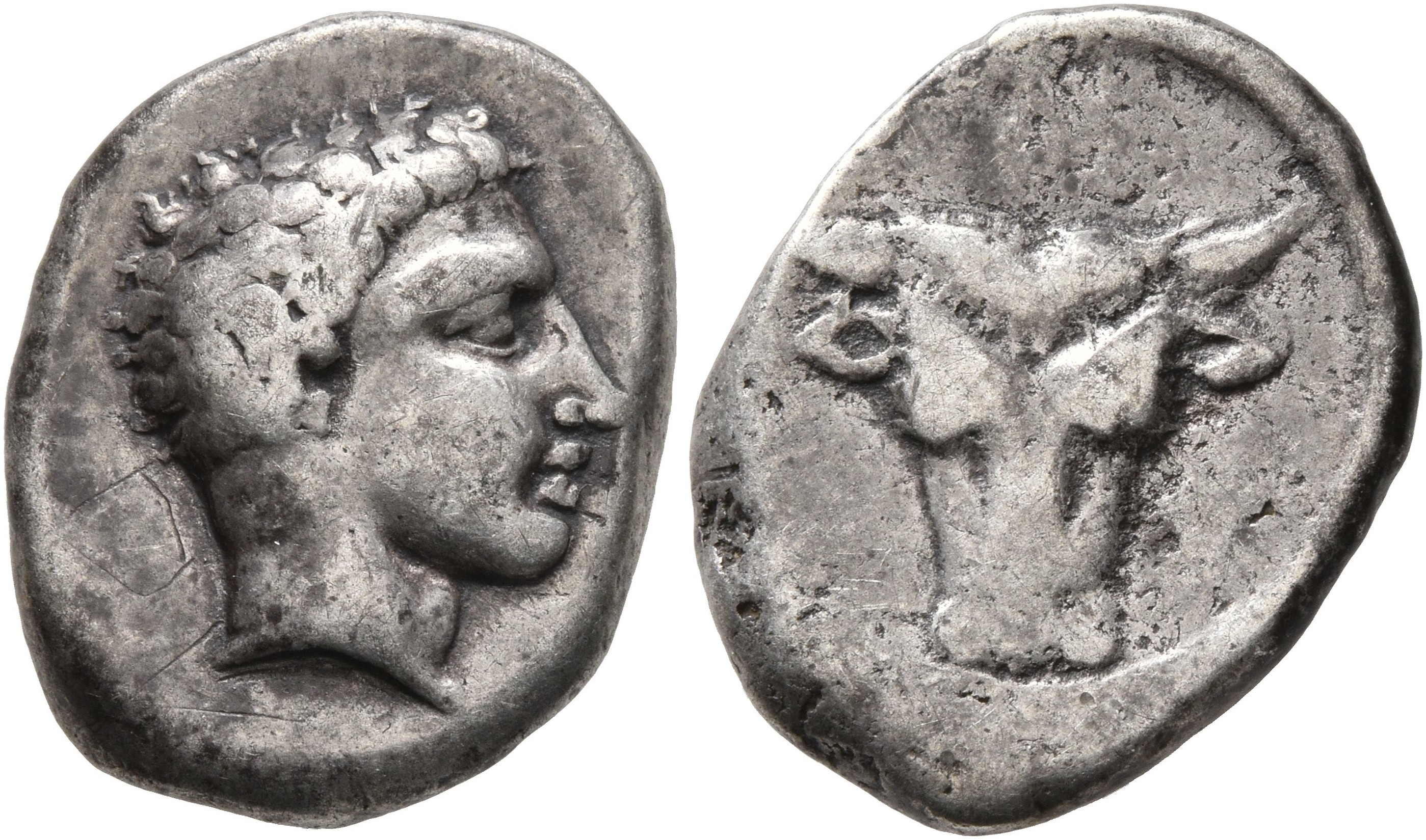Phaestus, silver, drachms (male head/facing bull) (350-300 BCE)
From SILVER
350 BCE - 300 BCE Silver 848 kg
Description
| ObverseInscription or printing placed on the obverse.: | Youthful male head (of Herakles?) to right. |
| ReverseInscription or printing placed on the reverse.: | Facing bull's head. |
Mint and issuing power
| MintIdentifies the place of manufacture or issue of a numismatic object.: | Phaestus | Ancient regionAncient region.: | Crete | Modern countryModern country: Crete | AuthorityIdentifies the issuing power. The authority can be "pretended" when the name or the portrait of X is on the coin but he/she was not the issuing power. It can also be "uncertain" when there is no mention of X on the coin but he/she was the issuing power according to the historical sources: |
Chronology
| FromIdentifies the initial date in a range assigned in a numismatic context. | 350 BCE | toIdentifies the final date in a range assigned in a numismatic context.. | 300 BCE | PeriodTime period of the numismatic object.: Classical 480-323 BC |
Physical description
| MetalThe physical material (usually metal) from which an object is made.: | Silver |
Median weightMedian of the weights of numismatic objects (in grams). in grams | 5.80 | DenominationTerm indicating the value of a numismatic object. Examples: tetradrachm, chalkous, denarius.: | drachm | StandardStandard.: |
Image

S 1562 - Phaestus, silver, drachms (350-300 BCE).jpg [1]
References
| Die study referencePublication of the study: | Carbone 20221Carbone 2022, p. 72 (Group E), 89-90 (Group J), 98-99 (Group M), 102-103 (Groups O-P) | ||
| Coin series referenceReference to coin series study: | Sear I2Sear I, n° 3205 | ||
| Coin series web referenceCoin series web references: | |||
Obverse dies distribution
| FrequencyFrequency of specimen in distribution. ᵖ | Number of obversesNumber of obverse dies. ᵖ (o) | % (o) | Number of coinsNumber of coins. (n) | % (n) | Die nameName(s) of the die(s). |
| 1 | 2 | 28.57 | 2 | 3.77 | 39, 40 |
| 2 | 1 | 14.29 | 2 | 3.77 | 7 |
| 3 | 1 | 14.29 | 3 | 5.66 | 34 |
| 10 | 1 | 14.29 | 10 | 18.87 | 22 |
| 11 | 1 | 14.29 | 11 | 20.75 | 42 |
| 25 | 1 | 14.29 | 25 | 47.17 | 23 |
| Total | 7 of 7 | 100.02 | 53 of 53 | 99.99 |
Reverse dies distribution
no distribution is available
Quantification
| Number of obversesNumber of obverse dies. ᵖ (o) | 7 | Number of singletons (o1)The number of singleton coins. ᵖ | 2 |
| Number of reverse diesNumber of reverse dies. (r) | 7 | Number of coinsNumber of coins. (n) | 53 |
| Coins per obverse dieNumber of coins per obverse die. (n/o) | 7.57 | Coins per reverse dieNumber of coins per reverse die. (n/r) | 7.57 |
| Reverse per obverse ratioRatio of obverse dies divided by reverse dies. (r/o) | 1 | Percentage of singletons (o1)number of coins (n) divided by the number of singletons (o1) ᵖ | 28.57 % |
| Original number of dies (O) (Carter 1983 formula)The estimation of the number of coins according to Carter 1983 ᵖ | 7.31 | Coins struck if 20,000 as average productivity per dieCoins made if the average productivity for obverses (according to Carter) is 20,000. ᵖ | 146,200 |
| Original number of dies (O) (Esty 2011 formula)The estimation of the number of coins according to the singleton formula in Esty 2011 ᵖ (O) | 8.07 | Survival rate if 20,000 as average productivity per dieSurvival rate if average productivity is 20,000. ᵖ | 0.00036 |
| Coverage (o = % of O) (Esty 1984 formula)Esty 1984 - coverage (% of O) ᵖ (o = % of O) | 96.23% | Die productivity if survival rate 1/2,000Average productivity if survival rate is 1/2,000. ᵖ | 14,500.68 |
| Weight of silver (in kg) if 20,000 coins per die (O = Carter formula)Carter 1983 * Median weight * 20000 (*10 if gold or electrum) ᵖ | 848 kg <br /> 848 kg | Die productivity if survival rate 1/5,000Average productivity if survival rate is 1/5,000. ᵖ | 36,251.71 |
Remarks
Most likely one single workstation